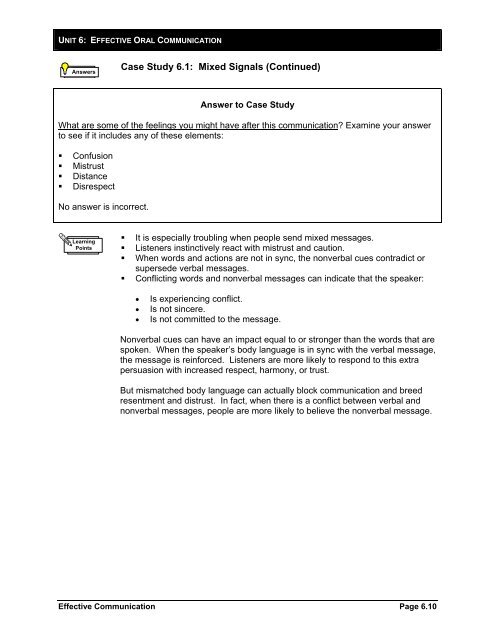Effective Communication - Emergency Management Institute ...
Effective Communication - Emergency Management Institute ...
Effective Communication - Emergency Management Institute ...
You also want an ePaper? Increase the reach of your titles
YUMPU automatically turns print PDFs into web optimized ePapers that Google loves.
UNIT 6: EFFECTIVE ORAL COMMUNICATION<br />
Answers<br />
Case Study 6.1: Mixed Signals (Continued)<br />
Answer to Case Study<br />
What are some of the feelings you might have after this communication? Examine your answer<br />
to see if it includes any of these elements:<br />
Confusion<br />
Mistrust<br />
Distance<br />
Disrespect<br />
No answer is incorrect.<br />
Learning<br />
Points<br />
It is especially troubling when people send mixed messages.<br />
Listeners instinctively react with mistrust and caution.<br />
When words and actions are not in sync, the nonverbal cues contradict or<br />
supersede verbal messages.<br />
Conflicting words and nonverbal messages can indicate that the speaker:<br />
• Is experiencing conflict.<br />
• Is not sincere.<br />
• Is not committed to the message.<br />
Nonverbal cues can have an impact equal to or stronger than the words that are<br />
spoken. When the speaker’s body language is in sync with the verbal message,<br />
the message is reinforced. Listeners are more likely to respond to this extra<br />
persuasion with increased respect, harmony, or trust.<br />
But mismatched body language can actually block communication and breed<br />
resentment and distrust. In fact, when there is a conflict between verbal and<br />
nonverbal messages, people are more likely to believe the nonverbal message.<br />
<strong>Effective</strong> <strong>Communication</strong> Page 6.10

















